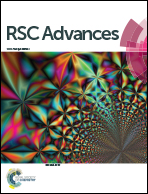Adenosine monophosphate-capped gold(i) nanoclusters: synthesis and lanthanide ion-induced enhancement of their luminescence†
Abstract
Reduction of Au3+ in the presence of just adenosine 5′-monophosphate (AMP) and a zwitterionic organic chemical buffering agent, specifically 4-(2-hydroxyethyl)-1-piperazineethanesulfonic acid (HEPES), combined with light exposure, gives rise to luminescent, water-soluble Au+ nanoclusters (Au+ NCs). The photoluminescence of these NCs is considerably enhanced by adding Y3+ or the chemically similar Yb3+ lanthanide that leads to Au+/Y3+ and Au+/Yb3+ NCs, respectively. These NCs are characterised by absorption (steady-state), photoluminescence (steady-state and time-resolved), and X-ray photoelectron spectroscopy.


 Please wait while we load your content...
Please wait while we load your content...